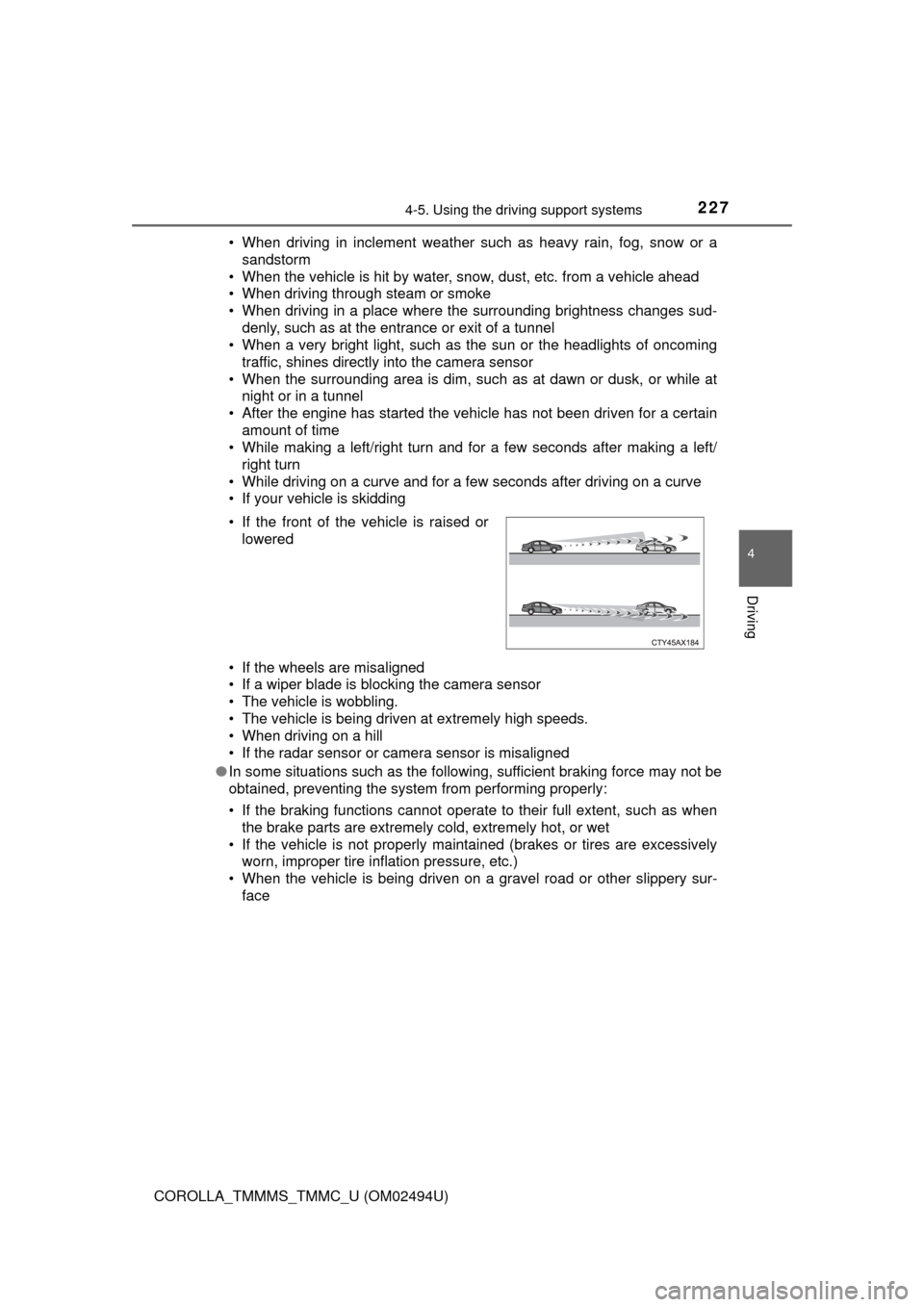2017 TOYOTA COROLLA inflation pressure
[x] Cancel search: inflation pressurePage 6 of 612

TABLE OF CONTENTS6
COROLLA_TMMMS_TMMC_U (OM02494U)7-1. Maintenance and care
Cleaning and protecting
the vehicle exterior .......... 412
Cleaning and protecting
the vehicle interior ........... 415
7-2. Maintenance
Maintenance
requirements ................... 418
General maintenance ........ 421
Emission inspection and
maintenance (I/M)
programs ......................... 425
7-3. Do-it-yourself
maintenance
Do-it-yourself service
precautions ..................... 426
Hood.................................. 429
Positioning a floor jack ...... 431
Engine compartment ......... 433
Tires .................................. 444
Tire inflation pressure........ 452
Wheels .............................. 455
Air conditioning filter .......... 457
Wireless remote control/
electronic key
battery ............................. 459
Checking and replacing
fuses ............................... 462
Light bulbs ......................... 4658-1. Essential information
Emergency flashers ........... 474
If your vehicle has to be
stopped in an
emergency....................... 475
8-2. Steps to take in an
emergency
If your vehicle needs
to be towed ...................... 477
If you think something is
wrong............................... 482
Fuel pump shut off
system ............................. 483
If a warning light turns
on or a warning buzzer
sounds ............................. 484
If a warning message or
indicator is displayed ....... 493
If you have a flat tire .......... 513
If the engine will not
start ................................. 525
If the electronic key does
not operate properly ........ 527
If the vehicle battery is
discharged ....................... 530
If your vehicle
overheats......................... 535
If the vehicle becomes
stuck ................................ 539
7Maintenance and care8When trouble arises
Page 15 of 612

15Pictorial index
COROLLA_TMMMS_TMMC_U (OM02494U)Windshield wipers . . . . . . . . . . . . . . . . . . . . . . . . . . . . . . . . . P. 204
Precautions against winter season . . . . . . . . . . . . . . . . . . . . . P. 268
To prevent freezing (windshield wiper de-icer)
* . . . . . . . . . . . P. 380
Fuel filler door . . . . . . . . . . . . . . . . . . . . . . . . . . . . . . . . . . . . P. 206
Refueling method . . . . . . . . . . . . . . . . . . . . . . . . . . . . . . . . . . . P. 206
Fuel type/fuel tank capacity . . . . . . . . . . . . . . . . . . . . . . . . . . . P. 544
Tires . . . . . . . . . . . . . . . . . . . . . . . . . . . . . . . . . . . . . . . . . . P. 444
Tire size/inflation pressure . . . . . . . . . . . . . . . . . . . . . . . . . P. 550
Winter tires/tire chain . . . . . . . . . . . . . . . . . . . . . . . . . . . . . P. 268
Checking/rotation/tire pressure warning system
*. . . . . . . . P. 444
Coping with flat tires . . . . . . . . . . . . . . . . . . . . . . . . . . . . . . P. 513
Hood . . . . . . . . . . . . . . . . . . . . . . . . . . . . . . . . . . . . . . . . . . . . P. 429
Opening . . . . . . . . . . . . . . . . . . . . . . . . . . . . . . . . . . . . . . . . . . P. 429
Engine oil . . . . . . . . . . . . . . . . . . . . . . . . . . . . . . . . . . . . . . . . . P. 544
Coping with overheat . . . . . . . . . . . . . . . . . . . . . . . . . . . . . . . . P. 535
Headlights/daytime running lights
*. . . . . . . . . . . . . . . . . . . P. 195
Front turn signal/parking lights . . . . . . . . . . . . . . . . . . . . . . P. 195
Daytime running lights
* . . . . . . . . . . . . . . . . . . . . . . . . . . . . P. 195
Front side marker lights . . . . . . . . . . . . . . . . . . . . . . . . . . . . P. 195
Turn signal lights
*. . . . . . . . . . . . . . . . . . . . . . . . . . . . . . . . . P. 193
Stop/tail lights/rear side marker lights . . . . . . . . . . . . . . . . P. 195
Back-up lights
Shifting the shift lever to R . . . . . . . . . . . . . . . . . . . . P. 183, 186, 191
License plate lights . . . . . . . . . . . . . . . . . . . . . . . . . . . . . . . . P. 195
4
5
6
7
Light bulbs of the exterior lights for driving
(Replacing method: P. 465, Watts: P. 551)
*: If equipped
8
9
10
11
12
13
14
15
Page 227 of 612

2274-5. Using the driving support systems
4
Driving
COROLLA_TMMMS_TMMC_U (OM02494U)• When driving in inclement weather such as heavy rain, fog, snow or a
sandstorm
• When the vehicle is hit by water, snow, dust, etc. from a vehicle ahead
• When driving through steam or smoke
• When driving in a place where the surrounding brightness changes sud-
denly, such as at the entrance or exit of a tunnel
• When a very bright light, such as the sun or the headlights of oncoming
traffic, shines directly into the camera sensor
• When the surrounding area is dim, such as at dawn or dusk, or while at
night or in a tunnel
• After the engine has started the vehicle has not been driven for a certain
amount of time
• While making a left/right turn and for a few seconds after making a left/
right turn
• While driving on a curve and for a few seconds after driving on a curve
• If your vehicle is skidding
• If the wheels are misaligned
• If a wiper blade is blocking the camera sensor
• The vehicle is wobbling.
• The vehicle is being driven at extremely high speeds.
• When driving on a hill
• If the radar sensor or camera sensor is misaligned
●In some situations such as the following, sufficient braking force may not be
obtained, preventing the system from performing properly:
• If the braking functions cannot operate to their full extent, such as when
the brake parts are extremely cold, extremely hot, or wet
• If the vehicle is not properly maintained (brakes or tires are excessively
worn, improper tire inflation pressure, etc.)
• When the vehicle is being driven on a gravel road or other slippery sur-
face • If the front of the vehicle is raised or
lowered
Page 267 of 612

2674-5. Using the driving support systems
4
Driving
COROLLA_TMMMS_TMMC_U (OM02494U)
WARNING
■Replacing tires
Make sure that all tires are of the specified size, brand, tread pattern and
total load capacity. In addition, make sure that the tires are inflated to the
recommended tire inflation pressure level.
The ABS, TRAC and VSC systems will not function correctly if different tires
are installed on the vehicle.
Contact your Toyota dealer for further information when replacing tires or
wheels.
■Handling of tires and the suspension
Using tires with any kind of problem or modifying the suspension will affect
the driving assist systems, and may cause a system to malfunction.
Page 411 of 612

411
7Maintenance and care
COROLLA_TMMMS_TMMC_U (OM02494U)7-1. Maintenance and care
Cleaning and protecting
the vehicle exterior .......... 412
Cleaning and protecting
the vehicle interior ........... 415
7-2. Maintenance
Maintenance
requirements ................... 418
General maintenance........ 421
Emission inspection and
maintenance (I/M)
programs......................... 425
7-3. Do-it-yourself
maintenance
Do-it-yourself service
precautions ..................... 426
Hood ................................. 429
Positioning a floor jack ...... 431
Engine compartment ......... 433
Tires .................................. 444
Tire inflation pressure ....... 452
Wheels .............................. 455
Air conditioning filter.......... 457
Wireless remote control/
electronic key
battery ............................. 459
Checking and replacing
fuses ............................... 462
Light bulbs......................... 465
Page 424 of 612

4247-2. Maintenance
COROLLA_TMMMS_TMMC_U (OM02494U)
Vehicle exterior
ItemsCheck points
Doors/trunk• Do the doors/trunk operate
smoothly?
Engine hood• Does the engine hood lock system
work properly?
Fluid leaks
• There should not be any signs of
fluid leakage after the vehicle has
been parked.
Tires
• Is the tire inflation pressure cor-
rect?
• The tires should not be dam-
aged or excessively worn.
• Have the tires been rotated
according to the maintenance
schedule?
• The wheel nuts should not be
loose.
Windshield wipers
• The wiper blades should not show
any signs of cracking, splitting,
wear, contamination or deforma-
tion.
• The wiper blades should clear the
windshield without streaking or
skipping.
WARNING
■If the engine is running
Turn the engine off and ensure that there is adequate ventilation before per-
forming maintenance checks.
Page 427 of 612

4277-3. Do-it-yourself maintenance
7
Maintenance and care
COROLLA_TMMMS_TMMC_U (OM02494U)
Light bulbs (→P. 465)
• Bulb with same number and watt-
age rating as original
• Phillips-head screwdriver
• Flathead screwdriver
• Wrench
Radiator/condenser (→P. 439)⎯
Tire inflation pressure (→P. 452)• Tire pressure gauge
• Compressed air source
Washer fluid (→P. 443)
• Water or washer fluid containing
antifreeze (for winter use)
• Funnel (used only for adding
water or washer fluid)
WARNING
The engine compartment contains many mechanisms and fluids that may
move suddenly, become hot, or become electrically energized. To avoid death
or serious injury, observe the following precautions.
■When working on the engine compartment
●Keep hands, clothing and tools away from the moving fan and engine
drive belt.
●Be careful not to touch the engine, radiator, exhaust manifold, etc. right
after driving as they may be hot. Oil and other fluids may also be hot.
●Do not leave anything that may burn easily, such as paper and rags, in the
engine compartment.
●Do not smoke, cause sparks or expose an open flame to fuel or the bat-
tery. Fuel and battery fumes are flammable.
●Be extremely cautious when working on the battery. It contains poisonous
and corrosive sulfuric acid.
ItemsParts and tools
Page 445 of 612

4457-3. Do-it-yourself maintenance
7
Maintenance and care
COROLLA_TMMMS_TMMC_U (OM02494U)
Your vehicle is equipped with a tire pressure warning system that uses
tire pressure warning valves and transmitters to detect low tire infla-
tion pressure before serious problems arise. (→P. 484)
◆Installing tire pressure warning valves and transmitters
When replacing tires or wheels, tire pressure warning valves and
transmitters must also be installed.
When new tire pressure warning valves and transmitters are
installed, new ID codes must be registered in the tire pressure
warning computer and the tire pressure warning system must be
initialized. Have tire pressure warning valves and transmitter ID
codes registered by your Toyota dealer. (→P. 447)
◆Initializing the tire pressure warning system
■The tire pressure warning system must be initialized in the fol-
lowing circumstances:
●When changing the tire size.
●When the tire inflation pressure is changed such as when chang-
ing traveling speed or load weight.
When the tire pressure warning system is initialized, the current tire
inflation pressure is set as the benchmark pressure.
Tire pressure warning system (if equipped)